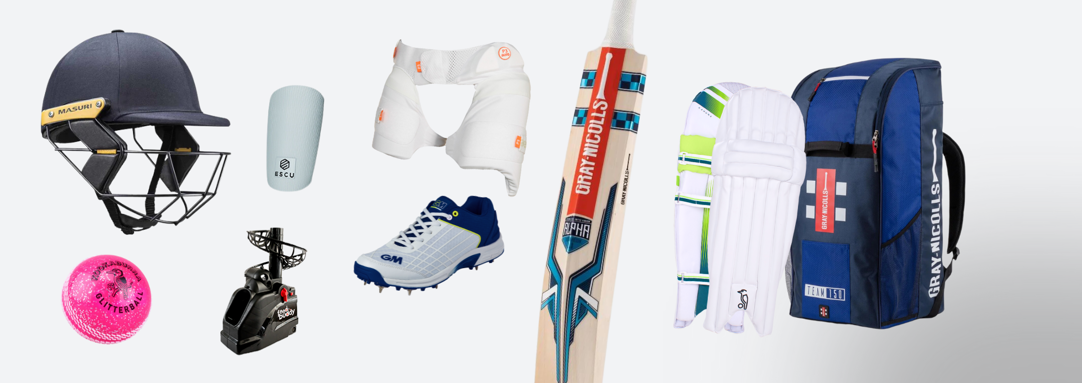- No products in the cart.

Cricket requires accuracy, skill, and endurance. Cricket players need skill and equipment to play well. A wide range of cricket gear lets players play safely and well. The bat that controls your swing and the safety gear that prevents injuries are all important. Baseball players know a good bat can make or break a game. Without gloves, helmets, and pads, even the best batter is vulnerable. Accessories, cricket training equipment, and clothing and shoes help you prepare and feel good. The right equipment makes practice feel like game time, giving cricket players the confidence to step on the pitch.
Cricket Bat—The Core of the Game
Every cricket game starts with a bat. It’s more than wood—the game needs it. The most common bat material is willow. They are balanced, stroke-friendly, and durable. Common willows include English and Kashmir. English willow bats are lighter and stronger, so pros prefer them. Because Kashmir willow bats are cheaper, beginners prefer them. Player height, style, and competition determine bat choice. A stroke-maker would use a lighter bat to hit with more control, while an aggressive batter would use a heavy one. You must select and maintain your bats. To avoid breaking new bats, “knock them in” and oil them. The bat is a cricketer’s most personal weapon.
Key Points:
- A cricket bat defines every stroke and scoring shot.
- English willow = power, Kashmir willow = durability.
- Proper knocking and oiling extend a bat’s life.
MATCH DAY CRICKET EQUIPMENT
Training is important, but when it comes to match day, every cricket club must be fully prepared and properly stocked with the right equipment. Some of the essential items include:
- Cricket Bat (match-ready and spare)
- Cricket Stumps and Bails
- Cricket Balls (new and extra)
- Scoreboard & Scorebook
- Umpire’s Kit (coat and ball counter)
- Boundary Ropes or Flags
In addition, all well-organized cricket clubs also maintain sight screens, pitch rollers, covers, and mowing equipment to ensure the ground is in top condition for play.
ADDITIONAL EQUIPMENT: CRICKET SETS AND BUNDLES
If you have a successful colts cricket section, you will need several Cricket Sets and soft cricket balls for training. If you are a wandering side, casual cricket team, or club with many occasional players, you may want to buy a Club Cricket Kit. If you like matching cricket gear and a particular brand, a cheap Cricket Bundle is a great way to buy your high-quality batting essentials in one go. Other relevant links:
- All about Cricket Bats
- Cricket Training Gear
- Cricket Clothing
- Cricket Accessories
Protective Gear—Safety First
Cricket ball speeds exceed 140 km/h. The game may look good. One delivery could end a player’s career without protection. Safety gear is considered as important as the bat. Batters and close fielders need helmets. It stops bouncers from hitting heads and faces. Leg pads and gloves protect the knees, shins, and fingers from hard hits. The abdominal guard, or “box,” is another essential piece of gear for players. Protect yourself with chest and arm guards against fast bowlers. Cushioned gloves and lighter pads help wicket keepers move quickly. Good protective gear keeps high-level players safe and boosts confidence. Protected players can focus on their technique instead of being scared, which improves their performance.
Key Points:
- Helmets protect the head and face from fast deliveries.
- Pads, gloves, and abdominal guards shield vital areas.
- Extra guards (chest/arm) add safety against bouncers.
Cricket Clothing—Comfort and Performance
Competitive cricket requires proper attire. Though less important than bats or helmets, they are. Playing in tight or sweaty clothes for hours is possible. You can’t concentrate. Traditional Test match uniforms are all white and called “whites.” Limited-overs players wear bright jerseys. Both materials breathe and absorb sweat, keeping you cool. Light, stretchy pants allow for easy movement. Your muscles will stay loose with compression underwear. Players wear wide-brimmed caps and hats during long seasons to avoid sunburn. You may feel better in wristbands and socks. Modern cricket clothes must do more than look good. They must work. It allows movement, keeps them cool in the sun, and looks good.
Key Points:
- Breathable jerseys and trousers improve comfort and flexibility.
- Caps and hats protect players from harsh sunlight.
- Good clothing boosts stamina and maintains a professional look.
Footwear – Grip and Stability
Cricketers need proper footwear. Balance and grip can make or break a four on the field. This is why every cricket gear list includes special shoes. Players wear spiked shoes on grass to run faster. For stability while running up, fast bowlers need spiked shoes. Exercise on concrete or artificial fields is best with rubber-soled shoes. They’re lighter, more flexible, and more comfortable for long walks. Without proper footwear, you may fall, twist your ankle, or injure yourself. But wearing the right shoes makes players run faster, feel better, and gain confidence. Shoes are a personal choice like the bat, but they’re crucial for cricket.
Key Points:
- Spiked shoes give a strong grip on turf pitches.
- Rubber-soled shoes suit practice on synthetic surfaces.
- Good shoes prevent slips and injuries and improve speed.
Cricket Training Equipment – Preparing Like a Pro
Training and having the best gear are equally important. Cricket practice gear comes in. Batsmen can practice without losing balls in practice nets, and bowling machines that simulate different speeds and styles improve reaction time. Fielders practice agility with cones to move faster and more coordinatedly. Competition cricket players need strength and endurance, which medicine balls and resistance bands can provide. Today’s players use video analysis to improve and correct mistakes. Players previously practiced alone. Modern training tools make skill acquisition faster and better. Practice gear is just as important as playing gear. Practice before games to win.
FAQs
Q1. What is the most important item in the cricket equipment list?
The cricket bat, as it defines the game itself.
Q2. Which protective gear is compulsory in competitive cricket?
Helmets, pads, gloves, and abdominal guards are essential.
Q3. Do beginners need the full cricket equipment list?
No, they can start with a bat, ball, gloves, and pads, then add more as they progress.
Q4. What is cricket training equipment used for?
It includes nets, cones, and bowling machines for skill improvement.
Q5. How often should a bat be replaced?
With regular use, a good bat lasts 1–2 seasons, but care can extend its life.

